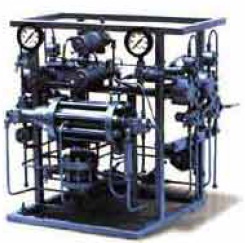The use of inhibitors is a common practice adopted in gas fields. The reasons are that the well fluids are almost always water saturated and at a rather high pressure. Therefore the cooling due to the fluid throttling at the
wellhead choke valves and along the pipeline up to the oil or gas center make it necessary to check if any risk of hydrate formation is to be considered.
And, very often, measures to avoid hydrates are to be taken. Generally,
inhibitors are used and the most commonly used inhibitors are:
ethylene glycol (EG), diethylene (DEG) and methanol (MeOH).
These compounds are injected at the wellhead. At the end of the pipeline, in the gas treating plant, the water phase with glycol is separated and the glycol recovered by heating and vaporizing the associated water.
Then, the glycol is pumped back to the well-head clusters by means of multi-stage centrifugal pumps.
At the well-head, glycol is injected in the well fluids usually by means of reciprocating dosing pumps.
Glycol is used in an aqueous solution with a concentration of 75 – 85% by weight.
Another hydrate inhibitor often used is methanol.
The comparison between these two hydrate inhibitors is as follows:
Glycol – advantages
– It does not vaporise in gas, although it forms solution with water. As a result, it can be recovered, regenerated and reintegrated.
Glycol – disadvantages
– Viscosity increases at low temperatures making injection difficult
Methanol– advantages
– Is a better inhibitor than glycol
– It is lighter and less viscous than glycol, it is consequently easier to pump.
Methanol – disadvantages
– A considerable amount of methanol vaporizes and remains in the product gas. This represents a considerable loss,
– The recovery of the methanol from the separated water is a costly process.
Injection of inhibitions for internal corrosion in pipelines Internal corrosion in carbon steel pipelines where wet and acidic gas-liquid well head fluid are transported, is usually mitigated by injecting proper corrosion inhibitors that can protect internal pipe walls in contact with liquid as well as with a gas phase.
Anti-corrosion treatments include the use of surface active corrosion inhibitors and the pH-stabilization technique. Such technique is a corrosion control method for wet gas pipelines based on the increase of the water
phase pH, forming a protective corrosion product layer. The liquid corrosion inhibitor is designed for oil and gas.
as many other chemical injection skids, this system consists of 2 injection “dosing” pumps “high pressure and low flow” , a chemical tank, and injectors.

